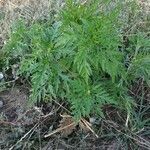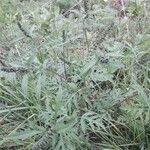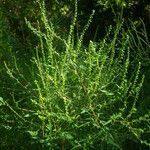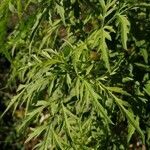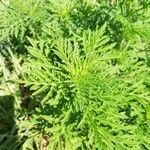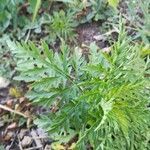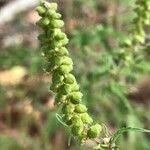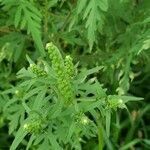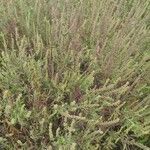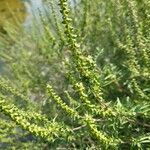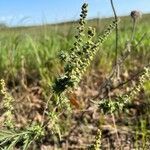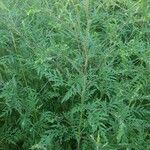Erect annual, 30-100 cm tall. Stems moderately clothed in short patent hairs and long erect hairs above, becoming glabrous below, much-branched. Lvs petiolate, moderately to densely clothed in short patent hairs below, less hairy above, often with long marginal hairs at base of petiole, deeply 2-3-pinnatisect, ovate, up to 15 cm long; ultimate segments (1)-2-7 mm wide; upper cauline lvs smaller, ± apetiolate and finally 1-pinnatisect. ♂ capitula pedunculate, 3-5 mm diam.; involucre saucer-shaped, shallowly lobed and usually ciliate. ♀ capitula solitary or clustered. Fruiting involucre glabrous or sparsely hairy, distinctly veined, 3-5 mm long, with a single series of 1-6 short spines around the flattened top; terminal beak 1-1.5 mm long.
Annuals, 10–60(–150+) cm. Stems erect. Leaves opposite (proximal) and alternate; petioles 25–35(–60+) mm; blades deltate to lanceolate or elliptic, 25–55(–90+) × 20–30(–50+) mm, 1–2-pinnately lobed, bases cuneate, ultimate margins entire or toothed, abaxial faces sparsely pilosulous to strigillose, adaxial faces strigillose, both gland-dotted. Pistillate heads clustered, proximal to staminates; florets 1. Staminate heads: peduncles 0.5–1.5 mm; involucres shallowly cup-shaped (usually without black nerves), 2–3+ mm diam., glabrous or hispid to pilosulous; florets 12–20+. Burs: bodies ± globose to pyriform, 2–3 mm, ± pilosulous, spines or tubercles 3–5+, near middles or distal, ± conic to acerose, 0.1–0.5+ mm, tips straight. 2n = 34, 36.
Annuals, 20-150 cm. Stems erect. Leaves opposite and alternate; petiole 2.5-3.5(-6) cm; blade deltate to lanceolate or elliptic, 2.5-5.5(-9) × 2-3(-5) cm, pinnately 1-or 2-lobed, abaxially sparsely pilosulose to strigillose, adaxially strigillose, both surfaces gland-dotted, base cuneate, ultimate margin entire or toothed. Female capitula clustered, proximal to male; floret 1. Male capitula: peduncles 0.5-1.5 mm; involucres shallowly cup-shaped (usually without black veins), 2-3 mm in diam., glabrous or hispid to pilosulose; florets 12-20. Burs ± globose to pyriform, 2-3 mm, ± pilosulose, spines or tubercles 3-5, near middle or apex, conical to acerose, 0.1-0.5 mm, tips straight. Fl. Jul-Oct, fr. Sep-Oct. 2n = 34, 36.
Erect annual herb 0.6–2 m high, shallow-rooted with taproot. Leaves opposite to alternate, 1–10 (–16) cm long, 1–4 (–6) cm wide, bipinnately divided; lobes lanceolate to oblong, finely hairy to ±glabrous, green to grey-green. Male capitula 3.0–3.5 mm diam., of 6–12 (–15) florets; involucral bracts fused 90–100% of their length; corollas glabrous. Female capitula in clusters of 1–6, each with 1 floret, often on short lateral inflorescences in upper leaf axils. Conceptacles obovoid, 3–4 mm long, with a single row of 0–5 short, ±straight, conical spines or teeth, and a terminal beak, with raised reticulate veins on surface, glabrous or sparsely pilose apically, eglandular.
Annual weed 3–10 dm, branching at least above, variously hairy or in part subglabrous; lvs opposite below, alternate above, once or more often twice pinnatifid, the blade narrowly to broadly ovate or elliptic in outline, 4–10 cm, the middle and lower ones, at least, evidently petiolate; staminate invols short-pedunculate, symmetrical or slightly oblique, inconspicuously nerved; fruiting invols 3–5 mm, 1-fld and 1 beaked, with a single series of short, sharp, erect spines near or above the middle; 2n=34, 36. Waste places; throughout our range, w. to the Pacific. (July) Aug.–Oct. (A. elatior; A. media)
A coarse, bushy annual herb up to 2 m tall, stems pilose when young, later rough-pubescent. Leaves mostly alternate, pinnatisect or bipinnatisect, the ultimate segments lanceolate or elliptic, on average more than 2 mm broad, obtuse, acute or acuminate, sometimes with 1 or 2 coarse teeth, pubescent on both surfaces, more densely so below, often drying very discolorous, aromatic or not. Male heads small, drooping, in slender terminal spikes up to c. 10 cm long, arranged in panicles, the female heads clustered in the leaf axils below them.
A coarse hairy annual herb. It grows 30 cm-1.5 m tall. The leaves are light green and highly dissected. They are 10 cm long. Male and female flowers are separate. Male flowers are small and in heads of 15-20 flowers. They are at the top of the plant. The female flowers do not have stalks and are in the axils of leaves.
Bushy annual herb, up to 2 m high. Ultimate leaf segments on average broader than 2 mm. Female heads several clustered in leaf axils below male heads. Flowers whitish, cream or yellowish.
